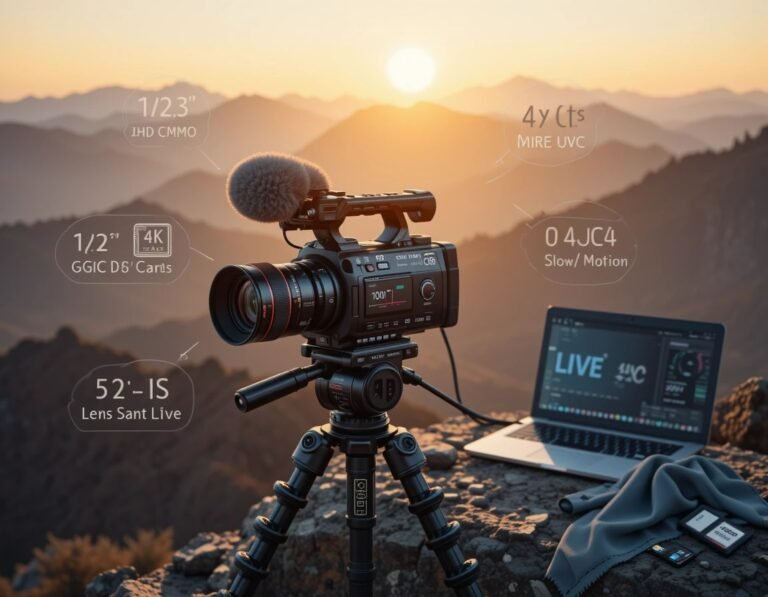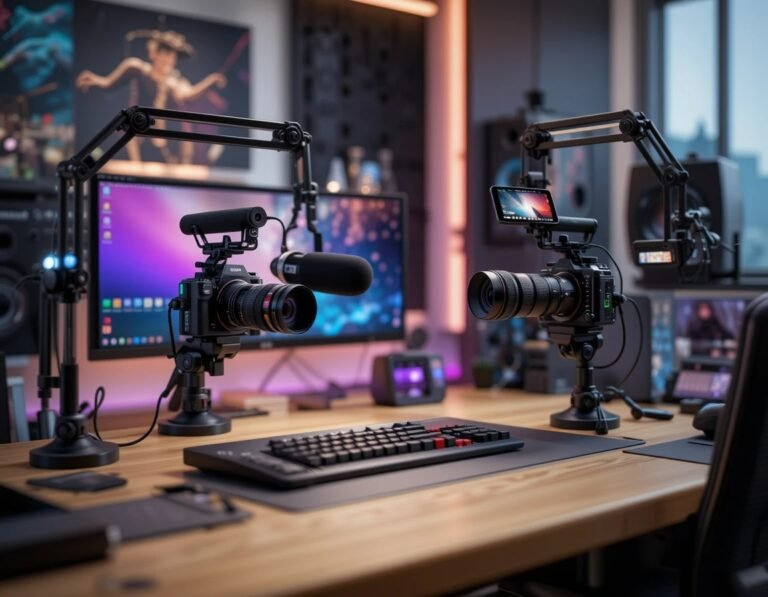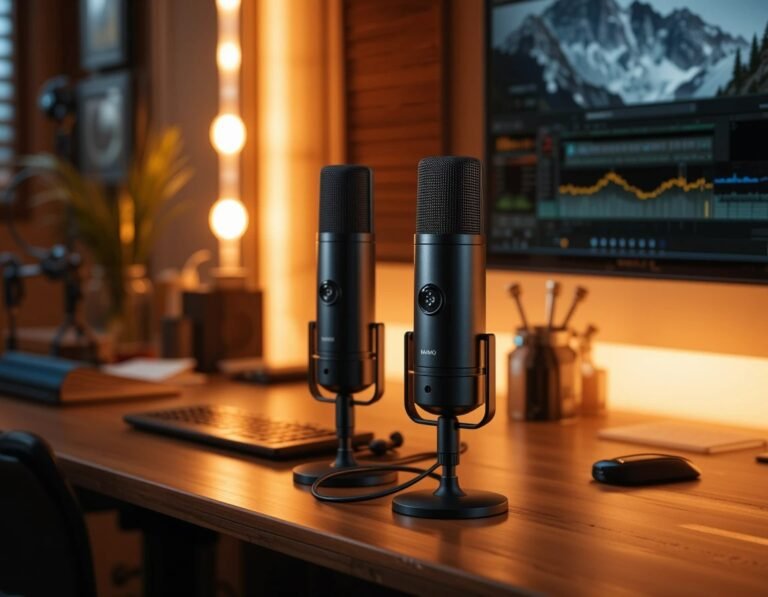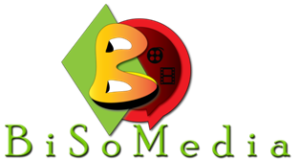Unlocking the Perfect Podcast Sound
Choosing the right microphone is crucial for any podcaster aiming for high-quality audio. This guide will help them navigate the various options available, empowering them to select a microphone that meets their unique needs and enhances their podcasting experience.
What You Need to Get Started
Understanding Microphone Types
Dynamic vs. Condenser: Which One Rules the Airwaves?Distinguish between dynamic and condenser microphones. Each type has unique characteristics suitable for different podcasting styles and environments.
Choose a dynamic microphone if recording in noisy surroundings. It captures sound predominantly from the front, minimizing background noise. For instance, if a podcaster records in a bustling cafe, a dynamic microphone, like the Shure SM58, would be ideal.
Opt for a condenser microphone for studio settings. It captures a wider frequency range and offers greater sensitivity to sound nuances, producing crisp audio quality. For example, a podcaster in a quiet room might choose a condenser microphone like the Audio-Technica AT2020 to capture their voice more richly.
Consider hybrid options, too. Some microphones combine features to cater to varied recording scenarios. For example, the Rode NT1-A is a versatile choice that works well in both controlled and less controlled environments.
Test out different types before making a purchase to find what sounds best for their unique voice and podcast format. Each microphone type offers distinct advantages, so ensuring the right fit is essential for creating engaging content.
Evaluating Audio Quality
Why Some Mic Sounds Like Velvet While Others Sound Like a Tin Can?Prioritize sound clarity and fidelity. When choosing a podcast microphone, audio quality can make or break the listening experience. Look for specifications like frequency response, which indicates the range of sounds the microphone can accurately capture. A frequency response of 20Hz to 20kHz is standard for capturing the full human voice spectrum.
Listen to sample recordings of potential microphones. Many manufacturers provide audio clips showcasing their products’ sound quality. For instance, if you’re considering the Rode NT1, play back its sample in a quiet environment to judge how it handles nuances in voice and sound.
Perform side-by-side comparisons. If possible, connect multiple microphones to an audio interface and record your voice using each one. This direct comparison helps in identifying which microphone captures the most authentic representation of their voice.
Check for additional features. Look for built-in pop filters or shock mounts that can enhance recording quality by minimizing unwanted sounds during spoken word.
Invest time in testing before buying. Good audio quality is not just about the microphone itself; it’s about how the microphone works in their specific recording setup.
Considering Connectivity Options
USB or XLR: Is the Simplicity of USB Worth the Trade-offs?Evaluate the connection types available for microphones. Podcasters typically have two main options: USB and XLR. Each has its unique advantages and disadvantages tailored to different needs and setups.
Choose a USB microphone for simplicity and convenience. These mics plug directly into a computer, making them perfect for beginners or podcasters recording at home. For example, the Blue Yeti is a popular USB option that offers a straightforward setup without the need for additional equipment.
Opt for an XLR microphone for professional audio quality and flexibility. XLR mics require an audio interface or mixer for connection, but they provide superior sound quality and control. If a podcaster plans to launch a more advanced studio setup or collaborate with other audio professionals, they might consider microphones like the Shure SM7B or the Audio-Technica AT2020.
Assess future growth. If a podcaster anticipates expanding their equipment, starting with an XLR microphone and interface could be beneficial. This option allows for upgrades and adjustments as the podcast evolves.
Weigh portability if on-the-go recording is a factor. USB microphones are often lightweight and easy to transport, ideal for recording in various locations, while XLR setups may be bulkier.
Make an informed choice based on individual needs and preferences. Understanding the implications of each connectivity type is key to achieving the best podcasting experience.
Setting a Budget That Works for You
Can You Really Get a Quality Mic Without Breaking the Bank?Set a realistic budget for your microphone purchase. Understanding your financial limits will help narrow down options effectively. For entry-level microphones, expect to spend between $50 and $150. Microphones like the Audio-Technica ATR2100x offer good quality at this price point.
Consider mid-range options for around $150 to $400. These often deliver superior audio quality and additional features. The Shure MV7, for example, is a favorite among serious podcasters looking for professional sound without a hefty investment.
Prepare to invest more for high-end microphones. In the $400+ range, expect premium audio quality and durability. Models like the Neumann TLM 102 are ideal for those ready to take their podcasting to the next level, delivering studio-quality sound.
Account for additional equipment. Don’t forget to factor in audio interfaces, pop filters, and stands, as these can enhance your microphone’s performance. Create a detailed budget to ensure all components align with your financial readiness, allowing for a smooth purchasing process.
Reading Reviews and Testing Options
How Can You Know If a Mic Lives Up to the Hype?Dive into user reviews and expert feedback. Start by searching for microphones on well-known audio gear websites and forums. Look at comments from actual users, focusing on notes about durability, sound clarity, and ease of use. For instance, if many reviews highlight issues with background noise on a specific model, it might not be the right choice for her needs.
Examine ratings from trusted sources. Check out professional reviews from audio experts who often conduct comparative testing. Websites like Wirecutter or TechRadar typically provide comprehensive analyses that can guide a decision.
Consider hands-on testing whenever possible. Visit local audio shops, where you can try out different microphones. Speak into each mic and listen to the playback. This experience is invaluable; for example, the tactile feel of a microphone may influence her preference significantly.
Make a comparison chart based on gathered information. List features, prices, and user ratings to visualize the differences. This systematic approach can clarify which microphone most suits her podcasting goals.
Final Thoughts on Your Podcasting Journey
Armed with this knowledge, readers can confidently select the microphone that elevates their podcasting experience. As they embark on this journey, they might wonder: how will the right microphone transform not only their sound quality but also their storytelling capabilities?











Nice article! I love the layout. The part about reading reviews was spot on. I always forget to do that. 😂 Gonna be more diligent this time!
Glad you liked it, James! Reviews can save you from making a bad purchase.
For real! I’ve bought a couple of duds because I skipped that part. 🙈
I love how informative this is. But honestly, the prices for good mics are crazy! 😩 How do you even start saving for one?
It can be tough, Derek! Maybe set aside a little each month specifically for your podcast gear?
That’s a good idea, Maya! I’ll keep an eye out.
Or look for second-hand options! You can find some great deals.
Great guide! I appreciate the final thoughts section too; it really puts things in perspective. Remember, it’s about the content, right? 🎙️
Exactly, Hannah! Focus on your message and the mic will just enhance it.
So true! I’ve heard some amazing podcasts with basic gear.
I appreciate the section on budget! It’s so easy to get carried away. I just want something decent without breaking the bank. Any suggestions?
I started with the Blue Snowball! It’s affordable and works well for beginners.
Absolutely! Look at the Samson Q2U or the Blue Snowball if you’re on a tight budget!
Thanks, Max! I’ll check those out.
Wow, this guide is super helpful! I never knew there were so many types of microphones. I’m leaning towards a condenser mic since I want that rich sound for my podcast. Any tips on specific brands? 🎤😊
What’s your budget, Sarah? There are good options for every price range!
I’ve got the AT2020, and I love it! Definitely recommend it for starters.
Glad you found it helpful, Sarah! For condenser mics, check out the Audio-Technica AT2020 or the Rode NT1. Both are great options!
I’m a total newbie, and this helped me so much. But I have to admit, I still feel like I need a PhD in microphones! 😂 Anyone else feel the same?
Haha, welcome to the club, Ben! It gets easier with time and practice.
Right? I still Google stuff every time I need to buy gear!
I’m totally overwhelmed by the options. I didn’t realize there were so many factors to consider! Anyone got a simple checklist?
Yes, please! That would be awesome!
I made a checklist based on this guide! Happy to share if you want.
Rachael, I feel you! A checklist could definitely help, but start with knowing your budget, mic type, and connectivity.
I’m still confused about the connectivity options. USB vs XLR? What’s the real difference? 🤔
Great question, Tommy! USB mics are usually plug-and-play, while XLR mics offer better sound quality and flexibility if you invest in an audio interface.
Thanks, Jessie! I think I will go for XLR then. Just need to figure out a good interface now.
XLR is the way to go if you’re serious about podcasting. USB is easier but limits you later on.
This guide made picking a mic feel a bit less daunting, but I’m still unsure about the audio quality part. What should I really focus on?
Also, consider the mic’s noise handling – that can make a huge difference!
Thanks for the tips! I’ll make sure to check those specs.
Focus on frequency response and sensitivity, Samira. Those are key for capturing quality sound.